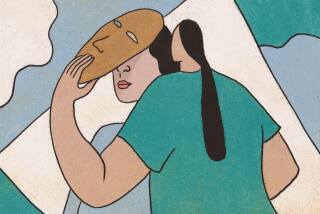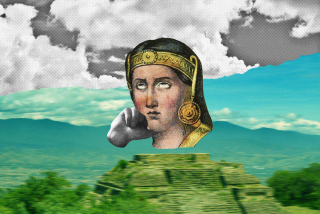The Trickster and Mr. Columbus : THE HEIRS OF COLUMBUS, <i> By Gerald Vizenor (Wesleyan University Press: $18.95; 189 pp.)</i>
- Share via
You’re not likely to hear too many lively discussions about the 1992 Columbus Quincentenary on any Indian reservation in the country. The promised “celebration” is just not a big deal there except in terms of “boycott.” But it’s clear that we may expect a plethora of publications on Columbus written by both Indians and whites to appear as the hour grows near.
“The Crown of Columbus,” by Michael Dorris and Louise Erdrich, is already out; “The Heirs of Columbus,” a mythopoeic space-age chronicle about bingo barges, healer genes and laser caravels by the mixed blood Anishinabe (Chippewa) writer, Gerald Vizenor, is next in line.
It is always risky to speculate about what publishers might be thinking, but it seems reasonably certain they’re placing their bets on the idea that whatever Latin writers like Alejo Carpentier, Carlos Fuentes, and Abel Posse can do, the premier Norte Indios writers can do better, i.e., extend the genealogy of Columbus’ creative colonial myth, or “bash” it by telling the real story of the genocidal horrors suffered by the indigenes as a result of the Columbus discovery. No revisionist stuff, please, just the real epic vision--”Dances With Columbus,” say.
“The Heirs of Columbus” may not be all of that, but it is a hilarious second.
Perhaps no Native American writer has been more interested in the threat of colonialism than Gerald Vizenor, nor more difficult to pin down. Part of that has to do with form, for Vizenor’s forte, literary/historical satire, is neither easily accessible nor well thought of except by the literati, and requires more intellectual investment than the quickly distracted readers of today are willing to render. “Heirs” takes time, patience. But with a little care, you will eventually find yourself sailing along from Samana Cay to Point Assinika in the waters between Washington state and Canada; from ship to museum, from crime to punishment, from myth to myth.
For Vizenor, being Indian has never been enough. Now he advances the idea that the Mixedblood figure, the Crossblood, the Halfbreed is a whole identity, not less than something whole. For in Vizenor’s view, the crossblood possesses the “gene of survivance.” The protagonist in “The Heirs of Columbus,” we are told, “resists the notion of blood quantums, racial identification, and tribal enrollment. The heir is a crossblood, to be sure, but there is more to his position than mere envy of unbroken tribal blood.” Indians, Vizenor’s hero says, are “forever divided by the racist arithmetic measures of tribal blood.”
In “Heirs,” Vizenor has ended colonialism through his own imagined creation of a Tribal Nation dedicated to healing. And in the most treasured of ironies, Christopher Columbus is a crossblood, too--a Mayan.
The main character is Stone Columbus, brother to the compassionate Naanabozho, the first trickster of Chippewa mythology. Born on a remote Indian reservation in Minnesota, Stone Columbus spreads his healing messages on CARP talk radio. He becomes the inspiration for a group of Indian storytellers who gather each autumn to imagine Columbus, and to advance the idea that the image of Columbus can be put to good use through their storytelling.
Thematically, Vizenor tells his readers that 500 years is long enough to be the victim of western oppression, that the survivors can turn it all around and imagine Columbus in their own ways. The explorer is taken out of his symbolism of domination--no mean accomplishment in these halcyon days of American hubris.
Since this is a trickster story in the tradition of Native American storytelling, normal novelistic plot is missing, but the strands of the tale contain myriad references to ongoing tribal politics. The gambling ship on which the new heirs arrive is taken over by the State, and Stone Columbus is charged with illegal gambling--a familiar story to tribes across the country. (Vizenor, an experienced newspaper writer, comes from a line of Minnesota Beaulieus who have offered critical analyses of federal Indian policy for a century.) The healer Felipa Flowers takes up the task of liberating sacred materials, and is accused by the Brotherhood of American Explorers of stealing museum artifacts.
Throughout the Flowers investigation, Almost Browne, another crossblood from the reservation, keeps everyone informed at tavern gatherings by presenting laser resurrections of everyone from Jesus Christ to Crazy Horse. This ecumenical spirit brings about the definition of tribal sovereignty, on Vizenor’s terms: “The notion of Tribal Sovereignty is not confiscable or earth bound; sovereignty is neither fence nor feathers.” The point is, the heirs transcend mere Indian-ness.
This may appear to be a denunciation of the tribal historical view, of the Bureau of Indian Affairs statistics, or both. It is, in fact, the trickster view for which Vizenor has become famous, a unique and oppositional non-tribal stance in the modern world. Some may consider it at odds with the reality of Indian life; but, if Satire is a sort of ritual, an ancient literary form used to curse one’s enemies and magically cure the ills of the world, anything can happen, any reality declared.
Vizenor brings to a head the essential questions in the final pages of “Heirs.” The Dangerous Windingoo arrives to wreck the new nation. Stone engages him in the Moccasin Game, re-creating the essential conflict of all myth, and Chippewa Myth in particular. Stone wins by arguing that balance is the bottom line; whoever wins really loses. Thus Evil is never destroyed, merely controlled: brought into balance.
In “Heirs,” Vizenor writes a modern Indian epilogue to the Columbus myth as incredible as any traditional stories. If you must read a book on Columbus during this commemorative period, this is the one.
More to Read
Sign up for our Book Club newsletter
Get the latest news, events and more from the Los Angeles Times Book Club, and help us get L.A. reading and talking.
You may occasionally receive promotional content from the Los Angeles Times.










